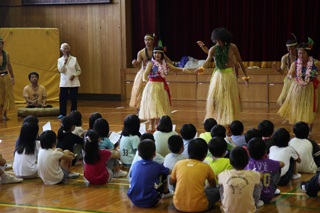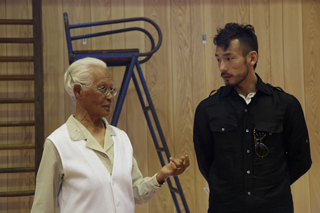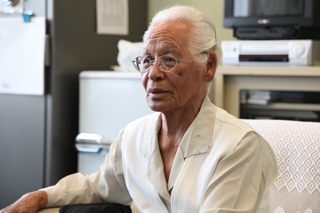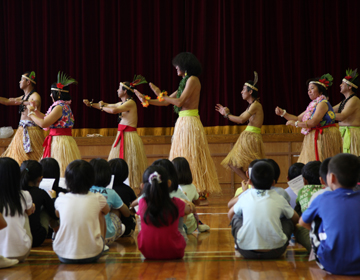Nanyo Dance Handed Down in Ogasawara

Dancing gracefully and joyously, wearing grass skirts and flowers in their hair, this is the ”Nanyo Dance” handed down in Ogasawara. The dance is derived from dances that were brought back from Saipan, Guam, and Micronesia, when they were under Japanese reign before the war. The Nanyo Dance and song flows and is quite mellow, making you feel calm and gentle. Of the 5 songs, the lyrics for one song ”Before Dawn” is from Palau but written in Japanese, while the other songs such as ”Urame” and ”Uwadoro” still use the original language. This adds to the ambience of Ogasawara Island, a typical south sea island.
During our visit, we saw elementary school children practicing their Nanyo Dance for the sports festival. The children danced along with the adults, wearing their grass skirts. This is how Nanyo Dance is passed on.
Kyoko Ohira was the singer during the visit, a woman who was born in Ogasawara, spending most of her life on the island.
Leaving the Islands During the War

Most of the islanders evacuated from Ogasawara during World War II. After the war, the islands became American territory. Only the ”Western islanders,” islanders with Western ancestry, were permitted to return to the islands while most were robbed of the opportunity to return to their homes. Ohira happened to be one of those allowed to return. After the war, she returned to the Ogasawara islands when it was still under American reign.
”Had the islands changed a lot from when you left it?” Nakata asked. ”There was nothing left,” Ohira answered quickly.
”Nothing. There were just rows of soldier barracks and we lived inside them. The windows were tiny, and it was tremendously hot. And then we realized that miraculously our house was left untouched.”
Ohira’s house had been used as a canteen and was left just as it was before the evacuation. She was allowed to return to that house, not that it meant that everything was back to normal.
The Making of “The Song of Ogasawara Restitution”

Under the reign of the United States, English was used in schools. Japanese was used in daily life, but many regulations were made that were not the same as in Japan. ”Wasn’t that difficult?” Nakata asked. ”Oh yes, of course there were many inconveniences, but the most difficult thing was the loneliness.” Ohira told us.
”Many of my friends were gone, which was very hard for me. That was the most difficult.” Only 130 people were allowed to return to the islands, consisting mainly of relatives or military-related people.
When Ogasawara was returned to Japan, she was ecstatic.
Ohira had been corresponding with her teacher on the mainland, and she wrote a verse about her emotions, added some music, recorded it, and sent it to her teacher. That is what is known today as ”The Song of Ogasawara Restitution”. He overflowing emotions became the lyrics of the song. The history of Ogasawara and the transition of the lives of the people of Ogasawara will continue to be handed down through ”The Nanyo Dance” and ”The Song of Ogasawara Restitution”.



